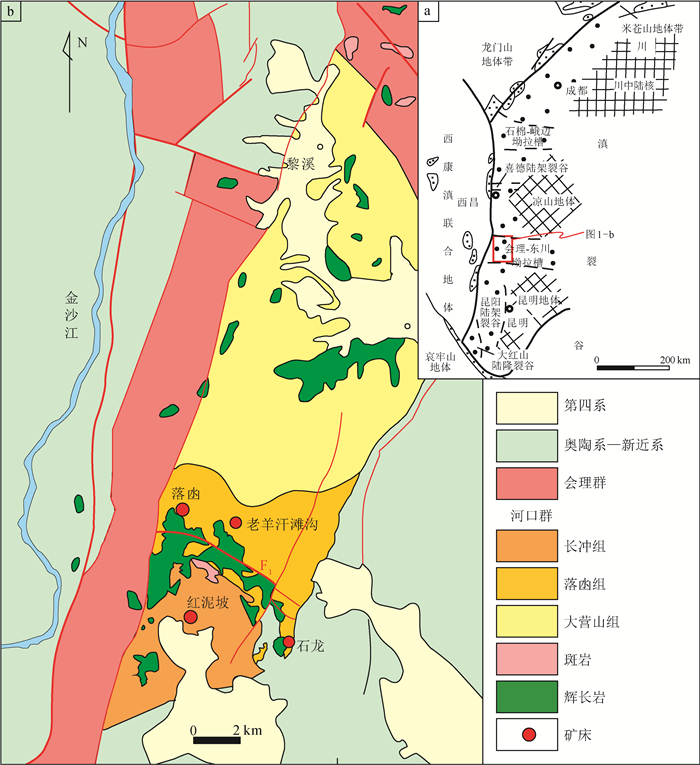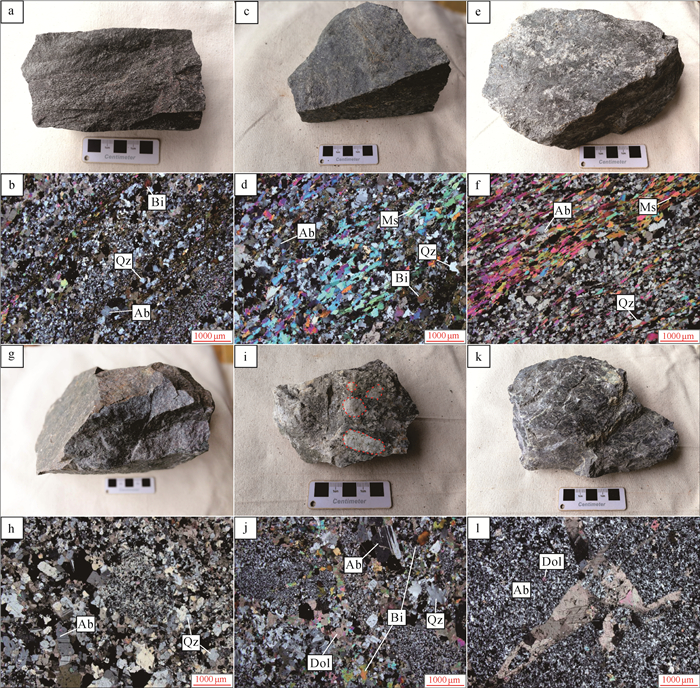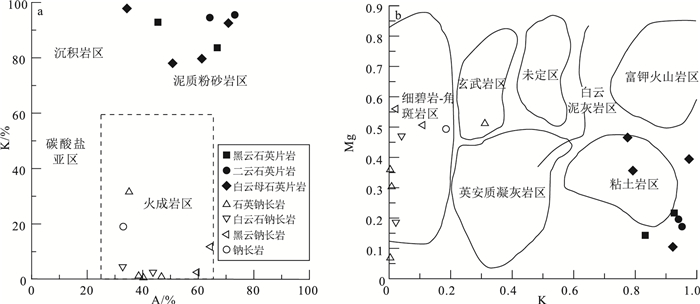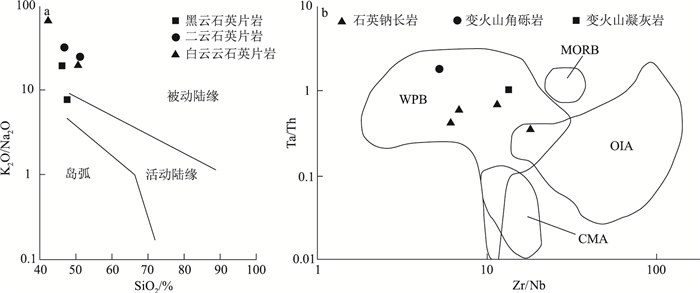Protolith reconstruction and its significance in the search for the ore-hosting metamorphic rock series in Hekou Group, the Lala copper orefield, Sichuan Province
-
摘要:
四川拉拉铜矿是中国著名的大型富铜矿床,其矿体均赋存于河口群变质岩系中,具有典型的层控特征,因此对这套变质岩开展原岩恢复工作能更好地限定其矿床成因,也可对区域下一步的深边部找矿提供指示。通过对赋矿变质岩开展了系统的岩相学和岩石地球化学研究,结果显示其原岩为一套泥质粉砂岩-细碧岩的岩石组合。其中,黑云石英片岩、二云石英片岩及白云石英片岩的原岩可能为泥质粉砂岩,而石英钠长岩、变火山角砾岩及变火山凝灰岩的原岩可能为细碧岩。河口群形成的构造环境可能为裂谷环境。结合矿体似层状、透镜状的层控特征及已有的成岩成矿年龄数据,认为该矿床存在早期VMS(火山成因块状硫化物矿床)型铜矿化,根据其围岩类型,可能属于"别子型"成矿亚类。本区此类矿床下一步找矿工作的方向为铁镁质火山岩与硅质碎屑岩的界面。
Abstract:The Lala copper deposit in Sichuan is one of the large copper-rich deposits in China.The ore bodies occur in the metamorphic rock series of the Hekou Group, and have typical stratabound characteristics.Therefore, the protolith reconstruction of this metamorphic rock can better define the genesis of the deposit and also provide directions for the next ore prospecting in this area.A series of geological and geochemical studies of its ore-bearing metamorphic rocks indicate that the original rocks are a set of argillaceous siltstone-spilite rock associations which were formed in an intracontinental rift of passive continental margin.The protoliths of biotite quartz schist, muscovite quartz schist and two-mica quartz schist are pelitic siltstone, while the original rocks of quartz albite, metavolcanic breccia and metavolcanic tuff are spilite.Based on the stratabound characteristics of stratiform as well as lenticular orebodies and diagenetic-metallogenic ages available, it is concluded that the deposit exhibits early VMS copper mineralization.Compared with the rock types of host rocks of different types of VMS deposits, Besshi type is considered to be of the early copper mineralization type.At last, the interface between mafic volcanic rocks and siliceous clastics in this region should be the direction of further prospecting work.
-
Keywords:
- Lala copper orefield /
- protolith reconstruction /
- tectonic setting /
- VMS deposits
-
致谢: 野外工作中承蒙四川省地质矿产勘查开发局四○三地质队和凉山矿业公司的帮助;论文在审稿过程中两位审稿专家提出了宝贵的意见,在此一并致谢。
-
表 1 主量元素分析结果及特征参数
Table 1 Major elements analytical results and characteristic parameters
% 样号 LD001 LD017 LD076 LD098 LD036 LD037 LD035 LD088 LD081 LD089 LD140 LD141 岩性 黑云石
英片岩黑云石
英片岩二云石
英片岩二云石
片岩白云石
英片岩白云石
英片岩石英
钠长岩石英
钠长岩石英
钠长岩石英
钠长岩变火山
角砾岩变火山
凝灰岩SiO2 46.22 47.60 46.90 51.30 50.71 42.37 48.76 44.14 41.34 40.67 50.18 50.69 TiO2 0.48 0.56 1.46 3.02 2.26 0.62 0.74 2.10 0.61 0.51 0.52 1.48 Al2O3 10.35 12.73 13.21 16.85 13.92 7.93 13.34 12.54 8.84 8.96 10.87 13.49 TFe2O3 17.52 21.36 24.75 11.91 18.28 12.07 4.50 13.03 4.49 9.60 4.90 8.30 MnO 0.36 0.51 0.16 0.15 0.61 1.29 0.30 0.42 0.47 0.71 0.19 0.19 MgO 2.51 1.82 2.86 1.48 1.10 4.42 1.06 1.55 1.41 4.58 2.50 2.41 CaO 5.40 1.38 1.88 3.09 1.23 12.26 13.37 8.24 21.35 12.71 13.27 7.06 Na2O 0.35 0.57 0.09 0.25 0.23 0.04 7.63 7.59 4.87 5.19 5.98 8.16 K2O 6.71 4.33 2.83 6.00 4.22 2.78 0.11 0.27 0.12 0.34 0.46 0.07 P2O5 0.12 0.13 1.16 1.15 1.00 0.15 0.17 1.12 0.16 0.17 0.32 0.82 烧失量 9.16 8.53 3.13 3.91 6.16 15.86 9.82 7.91 16.12 16.39 10.59 7.06 总计 99.17 99.52 98.44 99.11 99.72 99.81 99.82 98.90 99.79 99.84 99.77 99.73 FeO 13.39 14.16 17.08 8.27 11.38 7.17 1.51 6.69 2.62 6.40 2.47 2.47 KMg-K 0.93 0.83 0.95 0.94 0.92 0.98 0.01 0.02 0.02 0.04 0.05 0.01 MgMg-K 0.22 0.14 0.19 0.20 0.10 0.39 0.30 0.18 0.36 0.47 0.49 0.36 AA-C-FM 21.18 27.01 23.81 40.68 32.92 13.96 28.96 26.09 15.53 16.03 22.85 31.36 CA-C-FM 20.08 5.31 6.16 13.56 5.28 39.25 52.77 31.15 68.16 41.33 50.72 29.84 FMA-C-FM 58.74 67.67 70.03 45.76 61.80 46.79 18.28 42.76 16.31 42.65 26.43 38.80 KK-A 92.65 83.35 95.36 94.13 92.39 97.63 0.98 2.27 1.58 4.19 4.80 0.53 AK-A 45.39 66.98 73.34 64.34 71.04 34.45 38.72 43.78 25.14 32.93 35.54 46.89 DF3 5.62 -0.79 -4.92 5.00 -0.18 4.18 9.37 4.51 13.49 4.64 7.09 3.16 表 2 微量和稀土元素分析结果及特征参数
Table 2 Trace and rare earth elements analytical results and characteristic parameters
10-6 样号 LD001 LD017 LD076 LD098 LD036 LD037 LD035 LD088 LD081 LD089 LD140 LD141 a b 岩性 黑云石
英片岩黑云石
英片岩二云石
英片岩二云石
片岩白云石
英片岩白云石
英片岩石英
钠长岩石英
钠长岩石英
钠长岩石英
钠长岩变火山
角砾岩变火山
凝灰岩球粒
陨石[21]上
地壳[22]Rb 157.11 130.97 64.87 199.37 165.83 122.24 2.25 5.38 1.63 6.33 22.83 1.05 2.32 82 Ba 1343.12 1468.95 351.85 464.07 517.03 315.44 16.07 25.59 20.05 51.73 54.25 9.02 2.41 628 Th 9.99 11.99 10.54 5.58 5.95 7.40 1.16 9.37 1.38 0.90 0.86 2.99 0.029 10.5 U 3.04 2.83 14.31 7.71 1.62 0.97 1.01 26.55 1.70 0.70 1.08 3.20 0.008 2.7 K 55682.91 35936.19 23512.66 49838.53 35017.50 23089.48 953.03 2226.96 989.08 2863.30 3810.10 544.51 545 23244 Nb 9.60 9.96 75.93 84.63 67.24 9.44 10.29 64.38 6.62 14.74 37.08 38.22 0.246 12 Ta 0.68 0.75 4.28 6.00 4.59 0.62 0.76 3.87 0.47 0.52 1.54 3.08 0.014 0.9 Sr 73.76 20.41 34.43 31.65 17.22 82.44 57.69 89.59 149.92 100.03 42.77 54.45 7.26 320 Pb 1.51 0.99 1.24 0.53 1.05 1.61 1.45 0.85 0.24 0.07 0.09 0.45 2.47 17 P 543.40 578.74 5084.51 5025.71 4367.06 658.04 762.89 4888.67 712.95 720.29 1395.85 3590.48 1220 655 Zr 98.28 139.70 543.06 558.62 465.05 136.07 140.78 446.41 145.97 115.88 218.07 614.18 3.87 193 Hf 2.58 3.65 12.69 13.41 10.58 3.51 3.64 10.09 3.86 3.11 5.89 15.19 0.1066 5.3 Y 37.68 19.99 95.34 76.04 55.21 22.97 41.16 73.49 147.02 15.55 69.49 61.01 1.57 21 Ti 2887.21 3364.66 8780.51 18122.41 13571.17 3746.59 4411.11 12559.66 3672.91 3056.41 3096.32 8844.30 445 3836 Cr 80.09 85.69 3.49 51.42 17.42 42.92 74.60 22.79 31.79 30.53 46.44 18.75 - 35 Co 22.92 43.26 134.62 26.62 29.70 26.51 3.85 60.04 4.38 12.71 5.88 1.96 - 20 Ni 32.84 35.75 22.97 26.00 16.86 23.13 6.33 14.24 5.81 10.94 24.25 5.71 - 20 Ga 13.94 15.55 26.60 47.49 28.21 13.29 15.19 21.73 9.01 9.01 16.37 23.23 - 17 Li 19.36 8.90 21.34 52.59 8.09 7.18 1.36 0.85 1.63 1.01 5.07 1.23 1.57 24 Be 1.67 4.37 2.77 6.32 4.00 3.81 0.79 0.87 0.76 0.77 0.83 1.11 - - Sc 11.18 11.72 15.99 31.50 24.59 11.24 11.63 12.72 22.15 14.72 14.32 27.97 - 11 V 62.46 102.14 71.03 177.23 166.00 54.41 88.38 176.54 14.63 13.33 35.84 86.63 - 60 Sn 61.88 2.61 20.85 200.42 4.85 3.46 7.07 26.01 5.60 5.10 3.66 11.03 1.72 2.1 Cs 0.63 0.44 1.16 1.04 1.07 0.82 0.08 0.02 0.06 0.02 0.36 0.02 0.188 4.9 W 9.30 5.45 26.03 138.47 12.75 0.88 1.50 2.80 4.59 1.42 0.54 0.57 0.095 1.9 Th/Sc 0.89 1.02 0.66 0.18 0.24 0.66 0.10 0.74 0.06 0.06 0.06 0.11 Rb/Sr 0.81 0.61 0.01 0.09 0.04 0.32 0.53 0.05 0.22 0.26 0.21 0.03 - - Th/U 2.13 6.42 1.88 6.30 9.63 1.48 0.04 0.06 0.01 0.06 0.53 0.02 - - Ba/Rb 3.29 4.23 0.74 0.72 3.66 7.59 1.15 0.35 0.81 1.28 0.80 0.94 - - Zr/Hf 8.55 11.22 5.42 2.33 3.12 2.58 7.14 4.76 12.33 8.17 2.38 8.58 - - Sr/Ba 0.05 0.01 0.10 0.07 0.03 0.26 3.59 3.50 7.48 1.93 0.79 6.04 - - Cr/Zr 0.81 0.61 0.01 0.09 0.04 0.32 0.53 0.05 0.22 0.26 0.21 0.03 - - La 87.79 30.52 450.40 185.54 63.15 16.62 8.56 275.26 18.75 5.27 4.14 5.92 0.31 Ce 142.68 59.80 749.75 295.50 141.83 34.72 19.07 473.50 52.23 12.78 11.46 17.53 0.808 Pr 14.08 6.83 76.23 31.24 18.87 4.33 2.50 50.20 7.96 1.85 1.89 2.92 0.122 Nd 48.51 24.66 243.05 103.60 76.15 16.90 10.83 166.79 37.08 8.11 10.07 15.87 0.6 Sm 11.28 6.02 51.51 24.78 18.65 4.29 3.33 35.64 12.05 2.40 3.71 6.02 0.195 Eu 14.53 1.82 12.92 44.27 5.04 1.34 1.81 9.26 4.61 1.31 1.33 2.07 0.0735 Gd 9.11 4.62 31.98 21.35 14.79 4.42 4.74 25.45 16.56 2.80 6.93 9.77 0.259 Tb 1.32 0.67 4.26 3.09 2.17 0.72 0.99 3.39 3.33 0.48 1.45 1.75 0.0474 Dy 7.41 3.73 21.03 16.74 12.02 4.35 6.83 17.05 24.39 3.14 10.50 11.83 0.322 Ho 1.44 0.74 4.03 3.29 2.35 0.90 1.54 3.16 5.70 0.67 2.45 2.45 0.0718 Er 3.79 1.99 10.50 9.15 6.13 2.57 4.46 7.95 17.47 1.93 7.28 6.75 0.21 Tm 0.53 0.29 1.48 1.30 0.86 0.38 0.68 1.08 2.68 0.30 1.16 1.02 0.0324 Yb 3.12 1.78 8.60 8.61 5.21 2.48 4.38 6.13 17.94 1.98 7.69 6.51 0.209 Lu 0.43 0.26 1.12 1.19 0.77 0.37 0.65 0.81 2.57 0.32 1.20 0.90 0.0332 Sm/Nd 0.23 0.24 0.21 0.24 0.24 0.25 0.31 0.21 0.33 0.30 0.37 0.38 ∑REE 346.02 143.74 1666.89 749.64 367.97 94.41 70.36 1075.65 223.32 43.34 71.25 91.32 LREE 318.87 129.65 1583.87 684.92 323.68 78.22 46.10 1010.64 132.68 31.72 32.59 50.34 HREE 27.15 14.09 83.02 64.72 44.29 16.19 24.26 65.00 90.64 11.62 38.65 40.98 LREE/HREE 11.74 9.20 19.08 10.58 7.31 4.83 1.90 15.55 1.46 2.73 0.84 1.23 (La/Yb)N 18.98 11.58 35.30 14.53 8.18 4.52 1.32 30.28 0.70 1.79 0.36 0.61 (Dy/Y)N 1.54 1.36 1.59 1.26 1.50 1.14 1.01 1.81 0.88 1.03 0.89 1.18 δEu 2.62 0.62 0.54 3.58 0.55 0.60 0.94 0.54 0.67 1.01 0.56 0.57 δCe 0.57 0.18 0.59 0.54 0.79 0.67 0.10 0.64 0.95 0.64 0.56 1.14 -
陈根文, 程德荣, 余孝伟.四川拉拉铜矿黄铁矿标型特征研究[J].矿物岩石, 1992, 12(3):85-91. http://www.cnki.com.cn/Article/CJFDTotal-KWYS199203012.htm 陈根文, 夏斌.四川拉拉铜矿床成因研究[J].矿物岩石地球化学通报, 2001, 20(1):42-44. http://www.wanfangdata.com.cn/details/detail.do?_type=perio&id=kwysdqhxtb200101009 Chen W T, Zhou M F.Paragenesis, stable isotopes, and molybdenite Re-Os isotope age of the Lala Iron-Copper deposit, Southwest China[J].Economic Geology, 2012, 107(3):459-480. http://cn.bing.com/academic/profile?id=6106a9b88cf2521492adcdf38fa56db6&encoded=0&v=paper_preview&mkt=zh-cn
Zhu Z M, Sun Y L.Direct Re-Os dating of chalcopyrite from the Lalaiocg deposit in the Kangdian copper belt, China[J].Economic Geology, 2013, 108(4):871-882. doi: 10.2113/econgeo.108.4.871
申屠保涌.钠长岩类地质地球化学特征及变质变形与铜矿的形成——以四川会理拉拉铜矿床为例[J].沉积与特提斯地质, 2000, (3):77-91. http://www.wanfangdata.com.cn/details/detail.do?_type=perio&id=yxgdl200003014 孙燕, 舒晓兰, 肖渊甫.四川省拉拉铜矿床同位素地球化学特征及成矿意义[J].地球化学, 2006, 35(5):553-559. http://www.wanfangdata.com.cn/details/detail.do?_type=perio&id=dqhx200605011 何德锋, 钟宏, 朱维光.石榴石-黑云母地质温度计在四川拉拉铜矿床的应用[J].矿物学报, 2008, 28(2):127-134. http://www.wanfangdata.com.cn/details/detail.do?_type=perio&id=kwxb200802004 周家云, 郑荣才, 朱志敏, 等.拉拉铜矿黄铁矿微量元素地球化学特征及其成因意义[J].矿物岩石, 2008, 28(3):64-71. http://www.wanfangdata.com.cn/details/detail.do?_type=perio&id=kwys200803011 周家云, 陈家彪, 沈冰, 等.四川拉拉铜矿构造成矿动力学机制[J].大地构造与成矿学, 2008, 32(1):98-104. http://www.wanfangdata.com.cn/details/detail.do?_type=perio&id=ddgzyckx200801013 周家云, 郑荣才, 朱志敏, 等.四川会理拉拉铜矿辉长岩群地球化学与Sm-Nd同位素定年[J].矿物岩石地球化学通报, 2009, 28(2):111-122. http://www.wanfangdata.com.cn/details/detail.do?_type=perio&id=kwysdqhxtb200902002 周家云, 朱志敏, 陈家彪, 等.四川会理拉拉铜矿对会理-东川坳拉槽新元古代构造岩浆事件的成矿响应[J].沉积与特提斯地质, 2009, 29(3):84-89. http://www.wanfangdata.com.cn/details/detail.do?_type=perio&id=yxgdl200903013 朱志敏, 曾令熙, 周家云, 等.四川拉拉铁氧化物铜金矿床(IOCG)形成的矿相学证据[J].高校地质报, 2009, 15(4):485-495. doi: 10.3969/j.issn.1006-7493.2009.04.007 李泽琴, 王奖臻, 刘家军, 等.拉拉铁氧化物铜金钼稀土矿床Re-Os同位素年龄及其地质意义[J].地质找矿论丛, 2003, 18(1):39-42. doi: 10.6053/j.issn.1001-1412.2003.1.007 王奖臻, 李泽琴, 黄从俊.康滇地轴元古代重大地质事件与拉拉IOCG矿床成矿响应[J].地球科学进展, 2012, 27(10):1074-1079. http://www.wanfangdata.com.cn/details/detail.do?_type=perio&id=dqkxjz201210007 黄从俊, 李泽琴.拉拉IOCG矿床萤石的微量元素地球化学特征及其指示意义[J].地球科学进展, 2015, 30(9):1063-1073. http://www.wanfangdata.com.cn/details/detail.do?_type=perio&id=dqkxjz201509010 Chen W.Origin and tectonic environment of theLala Fe-Cu-(Mo, REE)deposit, Sichuan Province, SW China [D].PhD Thesis of The University of Hong Kong, 2013.
刘肇昌, 李凡友, 钟康惠, 等.扬子地台西缘构造演化与成矿[M].成都:成都电子科技大学出版社, 1996:48-100. 徐恒, 崔银亮, 陈贤胜, 等.云南西盟翁嘎科金矿区变质岩原岩恢复及地质意义[J].有色金属(矿山部分), 2015, 67(2):42-48. http://www.wanfangdata.com.cn/details/detail.do?_type=perio&id=ysjs-ks201502010 Sun S S, McDonough W F.Chemical and isotopic systematics of oceanic basalts: Implications for mantle composition and processes[C]//Saunders A D, Norry M J.Magmatism in the Ocean Basins.Geological Society London.Special Publications, 1989, 42: 313-345.
Taylor S R, McLennan S M.The Continental Crust:Its Composition and Evolution[M].Blackwell, Cambridge, Mass, 1985:1-312.
Boynton W V.Geochemistry of the rare earth elements: meteorite studies[C]//Henderson P.Rare earth element geochemistry.Elsevier, 1984: 63-114.
于海亮, 王根厚, 万永平.藏东巴青县北部酉西岩组岩石地球化学特征[EB/OL](2006-12-13)[2019-08-12].北京: 中国科技论文在线.http://www.paper.edu.cn/releasepaper/content/200612-209. 凤骏, 穆利修, 王哲, 等.新疆巴音布鲁克地区那拉提岩群变质岩原岩恢复及成因环境探讨[J].新疆地质, 2017, 35(4):407-416. http://www.wanfangdata.com.cn/details/detail.do?_type=perio&id=xjdz201704007 黄从俊, 李泽琴, 王奖臻, 等.拉拉铁氧化物-铜-金-铀矿床成矿时代分析[J].河南师范大学学报(自然科学版), 2012, 40(6):80-83. http://www.wanfangdata.com.cn/details/detail.do?_type=perio&id=henansfdxxb201206023 周世泰.恢复变质岩原岩的一种岩石化学方法[J].辽宁地质学报, 1981:178-188. 刘义德.用岩石化学成分确定斜长角闪岩类原岩的一种方法[J].区测情报, 1978, 1. 王仁民.变质岩原岩图解判别法[M].北京:地质出版社, 1987:50-51. 熊小辉, 肖加飞.沉积环境的地球化学示踪[J].地球与环境, 2011, 39(3):405-414. http://www.wanfangdata.com.cn/details/detail.do?_type=perio&id=dzdqhx201103020 张厚松, 罗香建.贵州锦屏青白口系清水江组浅变质岩系地球化学特征及原岩恢复的意义[J].贵州地质, 2015, 32(3):208-215. http://www.wanfangdata.com.cn/details/detail.do?_type=perio&id=gzdz201503008 陈德潜, 陈刚.实用稀土元素地球化学[M].北京:冶金出版社, 1990:1-268. 张德辉, 韩连升, 范广海, 等.弓长岭何家采区斜长角闪岩地球化学特征分析[J].科技资讯, 2016, 14(31):176-179. http://www.wanfangdata.com.cn/details/detail.do?_type=perio&id=kjzx201631093 宋叔和.黄铁矿型铜和多金属矿床世界范围内一些主要矿带和矿床类型的对比及研究趋势[C]//中国地质科学院矿床地质研究所文集(5).中国地质学会, 1982: 33. 查瓦里茨基A H.火成岩[M].北京:地质出版社, 1958. Roser B P, Korsch R J.Determination of Tectonic Setting of Sandstone-Mudstone Suites Using SiO2 Content and K2O/Na2O Ratio[J].The Journal of Geology, 1986, 94:635-650. doi: 10.1086/629071
张鸿翔.杨子板块西部大陆地幔地球化学特征及壳幔演化[D].中国科学院地质与地球物理研究所博士学位论文, 2001. 陈伟, 赵新福, 李晓春, 等.中国铁氧化物-铜-金(IOCG)矿床的基本特征及研究进展[J].岩石学报, 2019, 35(1):99-118. http://www.wanfangdata.com.cn/details/detail.do?_type=perio&id=ysxb98201901008 Terry C W, Zhou M F, Li X C, et al.In situ Pb-Pb isotopic dating of sulfides from hydrothermal deposits:a case study of the Lala Fe-Cu deposit, SW China[J].Mineralium Deposita, 2019, 54:671-682. doi: 10.1007/s00126-018-0833-1
Barrie C T, Hannington M D.Classification of VMS deposits based on the host rock compositions Volcanic-Associated Massive Sulfide Deposits:Processes and Examples in Modern and Ancient Settings[M].Economic Geology Monograph, Economic Geology Publishing Company, Littleton, CO, USA, 1999:1-13.
Pirajno F, Chen Y, Li N, et al.Besshi-type mineral systems in the Palaeoproterozoic Bryah Rift-Basin, Capricorn Orogen, Western Australia:Implications for tectonic setting and geodynamic evolution[J].Geoscience Frontiers, 2016, 7(3):345-357. doi: 10.1016/j.gsf.2015.09.003




 下载:
下载:




